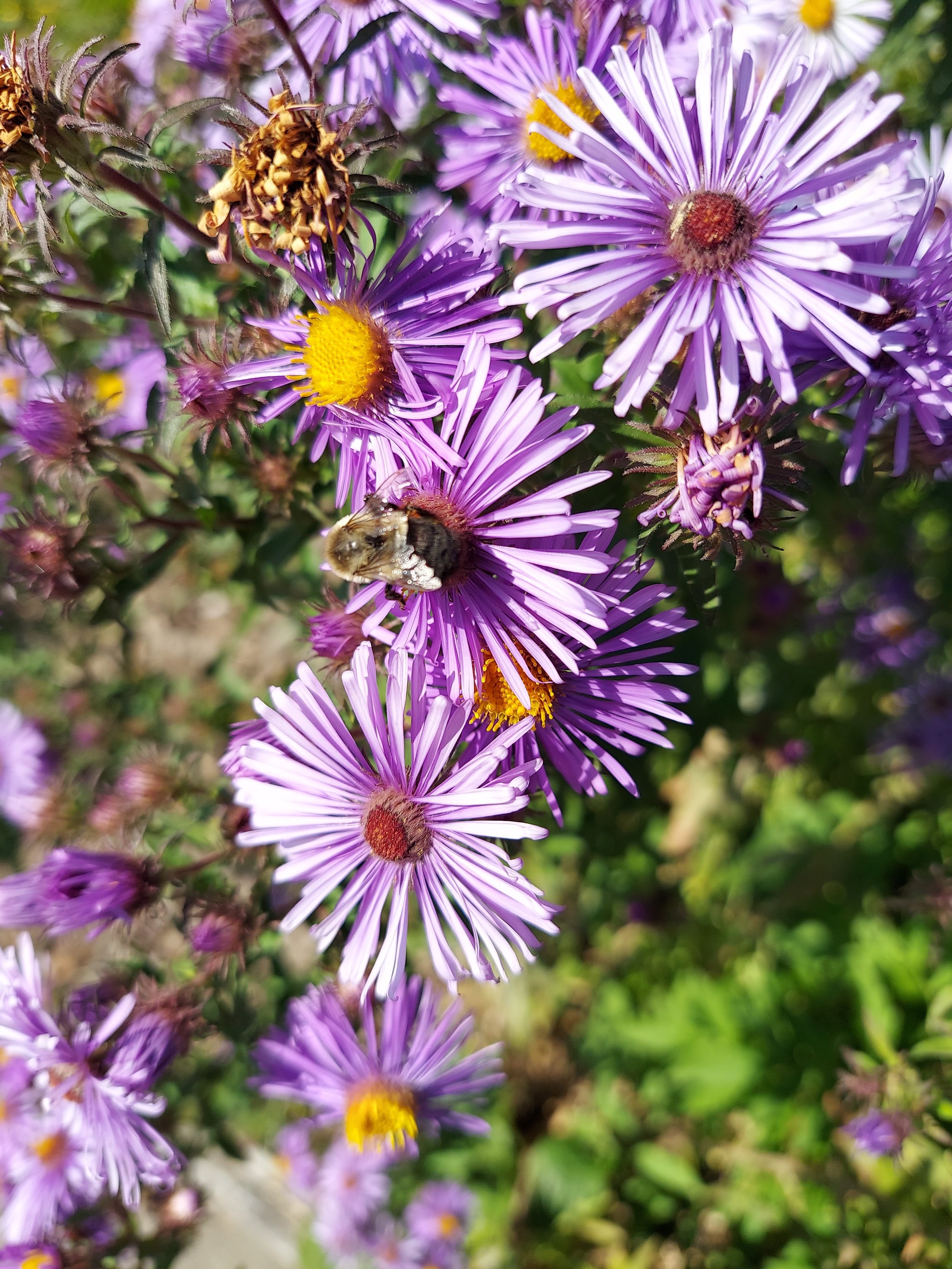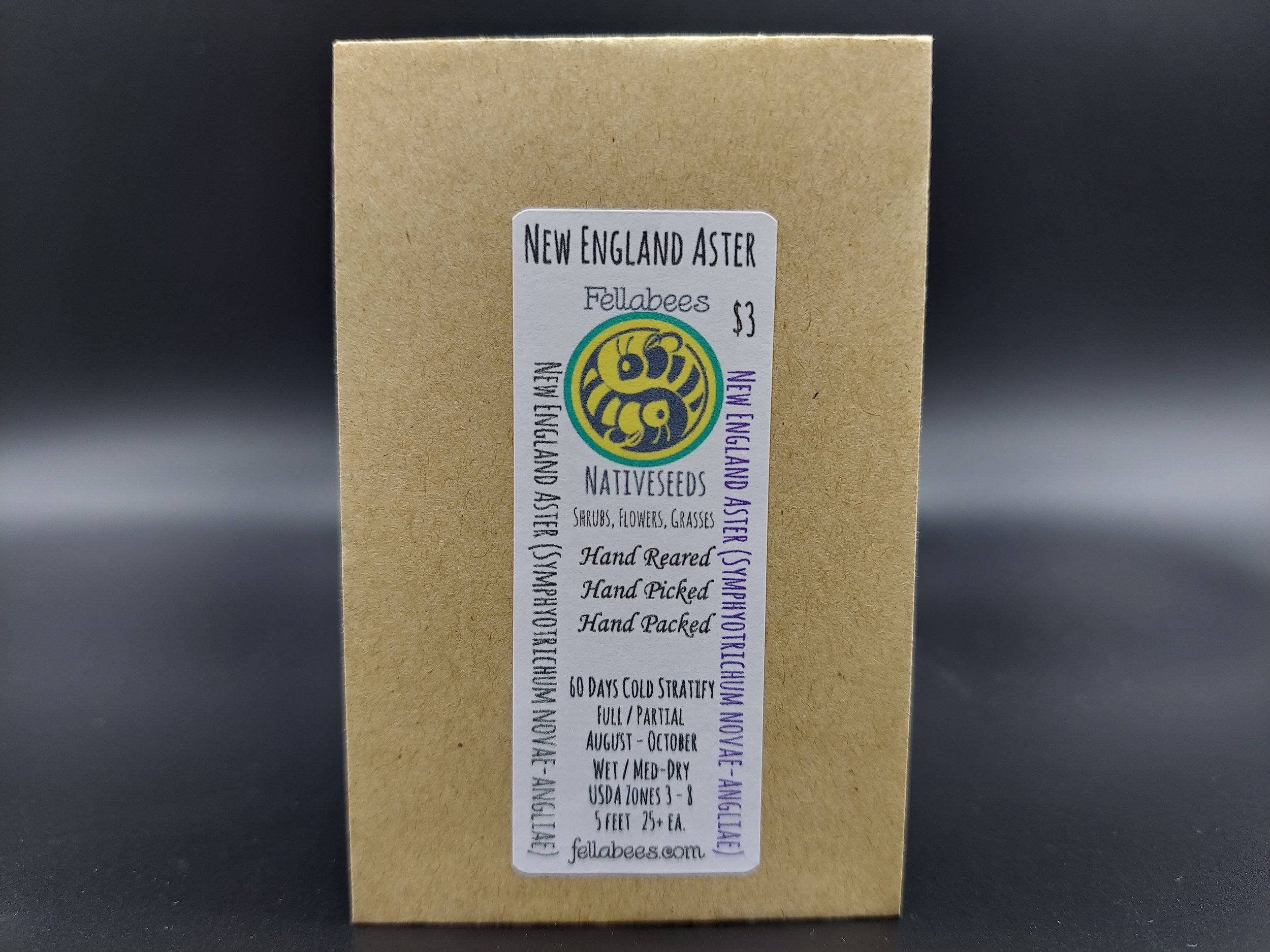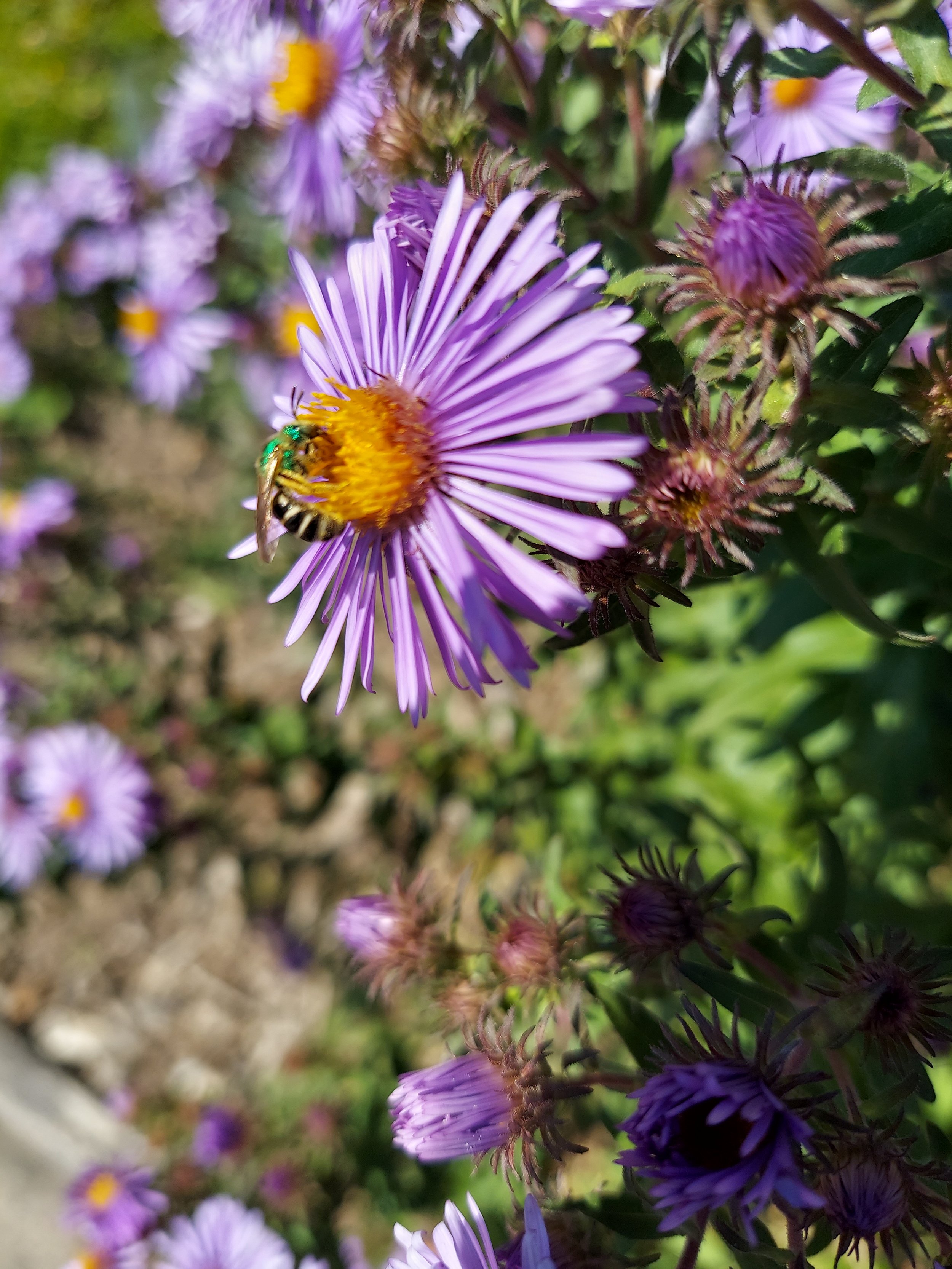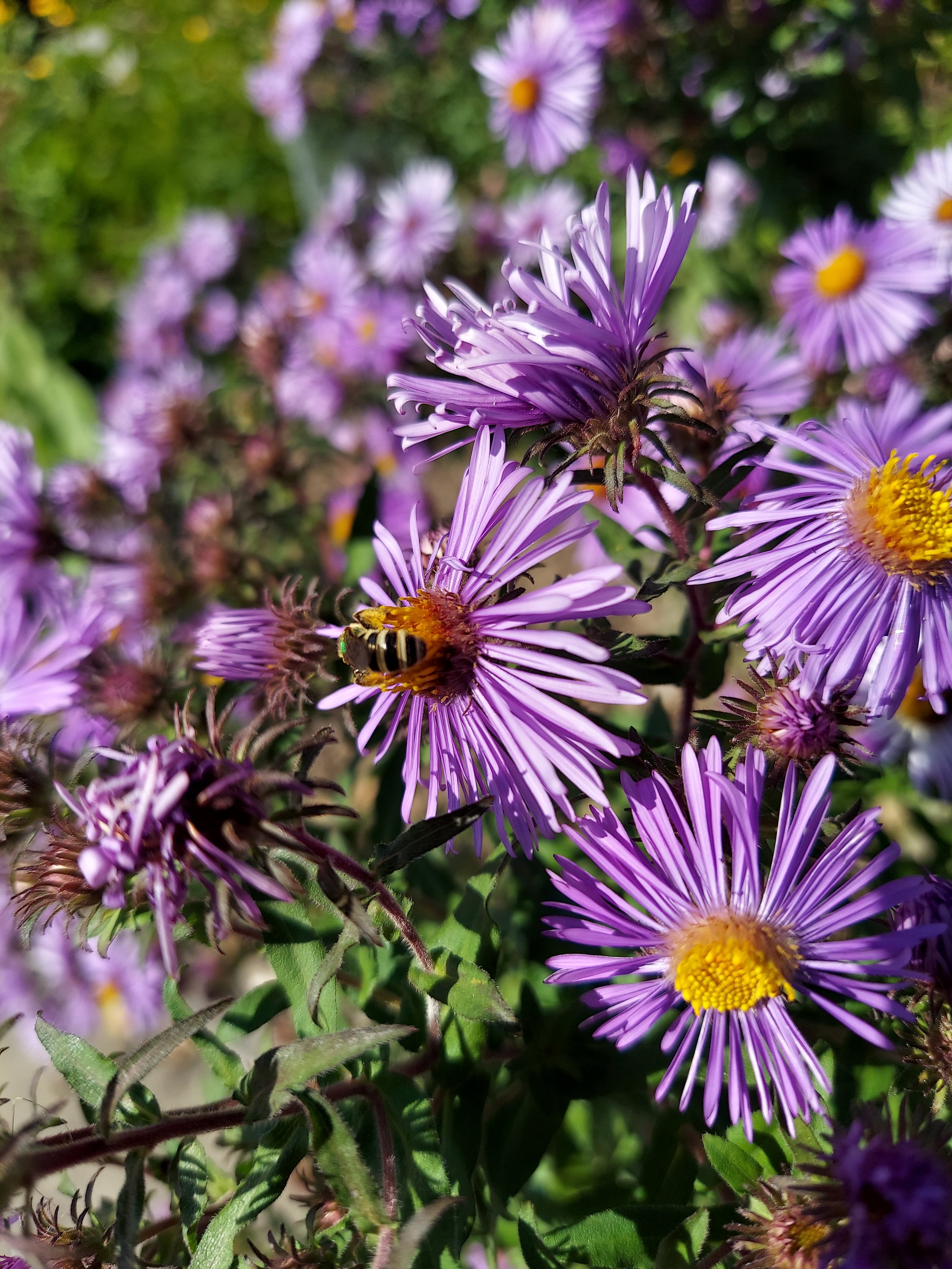 Image 1 of 4
Image 1 of 4

 Image 2 of 4
Image 2 of 4

 Image 3 of 4
Image 3 of 4

 Image 4 of 4
Image 4 of 4





New England Aster (Symphyotrichum novae-angliae)
New England Aster (Symphyotrichum novae-angliae)
New England Aster (Symphyotrichum novae-angliae)
Symphyotrichum novae-angliae (formerly Aster novae-angliae) is a species of flowering plant in the aster family (Asteraceae). This tenacious plant is native to central and eastern North America. Most commonly known as the New England Aster, it is a perennial, herbaceous plant usually between 1 and 4 feet tall and 2 to 3 ft wide.
New England Aster generally grows in wet environments but also has been found in dry soil or sand. The seeds and nectar of this mostly conservationally secure species, which blooms August to November, are important to a vast variety of animals, including birds, bees, and butterflies.
A wide variety of generalist nectar-feeding insects visit S. novae-angliae, including butterflies, moths, ants, flies, and bees. It is heavily visited by long-tongued bumblebees like the Golden Northern Bumble Bee (Bombus fervidus) and the Half-Black Bumblebee (Bombus vagans), and less so by short-tongued species. Some bees will collect pollen in addition to nectar, such as the Broad-handed Leafcutter Bee (Megachile latimanus) and Drury's Long-Horned Bee (Melissodes druriellus). The butterfly known to feed on New England Aster as a caterpillar is the Gorgone Checkerspot (Chlosyne gorgone)
Plant Details:
USDA Zones: 3-8
Germination Needs: 60 Day Cold Stratification
Life Cycle: Perennial
Sun Exposure: Full to Partial
Soil Moisture: Wet, Medium-Wet, Medium, Medium-Dry
Plant Spacing: 2-3 feet
Height: 5 feet
Bloom Time: August, September, October, November
Bloom Color: Purple
Advantages
Pollinator Favorite: butterflies, moths, bees, wasps, beetles
Bird Favorite: seeds, insects, fruit, nectar, nesting, perchs.
Deer Resistant: Yes
Excellent in the home landscape!
.
.
Packet quantities:
We pride ourselves on ethical, hands on, ecological management, using no mechanical or chemical methods whatsoever.
All of our native seed is hand reared, hand picked, and hand packed from native prairies under our exclusive management, never breaking chain of custody from the field until it is sent to you. Each packet is hand prepared for shipment by us, directly.
Small seed species will contain greater than 20-25 seed
Large seed species will contain greater than 10-15 seed
It is our mission to spread the wealth of native plant and pollinator ecological sustainability, and educate back yard gardeners as well as corporate and government entities in how to germinate, grow, and benefit from native synergies.
Thank you for your support, it is because of you, that we can grow together to do, what we do.🐛🦋🐝🐞🌾🌱🌼🧡
New England Aster (Symphyotrichum novae-angliae)
New England Aster (Symphyotrichum novae-angliae)
Symphyotrichum novae-angliae (formerly Aster novae-angliae) is a species of flowering plant in the aster family (Asteraceae). This tenacious plant is native to central and eastern North America. Most commonly known as the New England Aster, it is a perennial, herbaceous plant usually between 1 and 4 feet tall and 2 to 3 ft wide.
New England Aster generally grows in wet environments but also has been found in dry soil or sand. The seeds and nectar of this mostly conservationally secure species, which blooms August to November, are important to a vast variety of animals, including birds, bees, and butterflies.
A wide variety of generalist nectar-feeding insects visit S. novae-angliae, including butterflies, moths, ants, flies, and bees. It is heavily visited by long-tongued bumblebees like the Golden Northern Bumble Bee (Bombus fervidus) and the Half-Black Bumblebee (Bombus vagans), and less so by short-tongued species. Some bees will collect pollen in addition to nectar, such as the Broad-handed Leafcutter Bee (Megachile latimanus) and Drury's Long-Horned Bee (Melissodes druriellus). The butterfly known to feed on New England Aster as a caterpillar is the Gorgone Checkerspot (Chlosyne gorgone)
Plant Details:
USDA Zones: 3-8
Germination Needs: 60 Day Cold Stratification
Life Cycle: Perennial
Sun Exposure: Full to Partial
Soil Moisture: Wet, Medium-Wet, Medium, Medium-Dry
Plant Spacing: 2-3 feet
Height: 5 feet
Bloom Time: August, September, October, November
Bloom Color: Purple
Advantages
Pollinator Favorite: butterflies, moths, bees, wasps, beetles
Bird Favorite: seeds, insects, fruit, nectar, nesting, perchs.
Deer Resistant: Yes
Excellent in the home landscape!
.
.
Packet quantities:
We pride ourselves on ethical, hands on, ecological management, using no mechanical or chemical methods whatsoever.
All of our native seed is hand reared, hand picked, and hand packed from native prairies under our exclusive management, never breaking chain of custody from the field until it is sent to you. Each packet is hand prepared for shipment by us, directly.
Small seed species will contain greater than 20-25 seed
Large seed species will contain greater than 10-15 seed
It is our mission to spread the wealth of native plant and pollinator ecological sustainability, and educate back yard gardeners as well as corporate and government entities in how to germinate, grow, and benefit from native synergies.
Thank you for your support, it is because of you, that we can grow together to do, what we do.🐛🦋🐝🐞🌾🌱🌼🧡
New England Aster (Symphyotrichum novae-angliae)
New England Aster (Symphyotrichum novae-angliae)
Symphyotrichum novae-angliae (formerly Aster novae-angliae) is a species of flowering plant in the aster family (Asteraceae). This tenacious plant is native to central and eastern North America. Most commonly known as the New England Aster, it is a perennial, herbaceous plant usually between 1 and 4 feet tall and 2 to 3 ft wide.
New England Aster generally grows in wet environments but also has been found in dry soil or sand. The seeds and nectar of this mostly conservationally secure species, which blooms August to November, are important to a vast variety of animals, including birds, bees, and butterflies.
A wide variety of generalist nectar-feeding insects visit S. novae-angliae, including butterflies, moths, ants, flies, and bees. It is heavily visited by long-tongued bumblebees like the Golden Northern Bumble Bee (Bombus fervidus) and the Half-Black Bumblebee (Bombus vagans), and less so by short-tongued species. Some bees will collect pollen in addition to nectar, such as the Broad-handed Leafcutter Bee (Megachile latimanus) and Drury's Long-Horned Bee (Melissodes druriellus). The butterfly known to feed on New England Aster as a caterpillar is the Gorgone Checkerspot (Chlosyne gorgone)
Plant Details:
USDA Zones: 3-8
Germination Needs: 60 Day Cold Stratification
Life Cycle: Perennial
Sun Exposure: Full to Partial
Soil Moisture: Wet, Medium-Wet, Medium, Medium-Dry
Plant Spacing: 2-3 feet
Height: 5 feet
Bloom Time: August, September, October, November
Bloom Color: Purple
Advantages
Pollinator Favorite: butterflies, moths, bees, wasps, beetles
Bird Favorite: seeds, insects, fruit, nectar, nesting, perchs.
Deer Resistant: Yes
Excellent in the home landscape!
.
.
Packet quantities:
We pride ourselves on ethical, hands on, ecological management, using no mechanical or chemical methods whatsoever.
All of our native seed is hand reared, hand picked, and hand packed from native prairies under our exclusive management, never breaking chain of custody from the field until it is sent to you. Each packet is hand prepared for shipment by us, directly.
Small seed species will contain greater than 20-25 seed
Large seed species will contain greater than 10-15 seed
It is our mission to spread the wealth of native plant and pollinator ecological sustainability, and educate back yard gardeners as well as corporate and government entities in how to germinate, grow, and benefit from native synergies.
Thank you for your support, it is because of you, that we can grow together to do, what we do.🐛🦋🐝🐞🌾🌱🌼🧡
